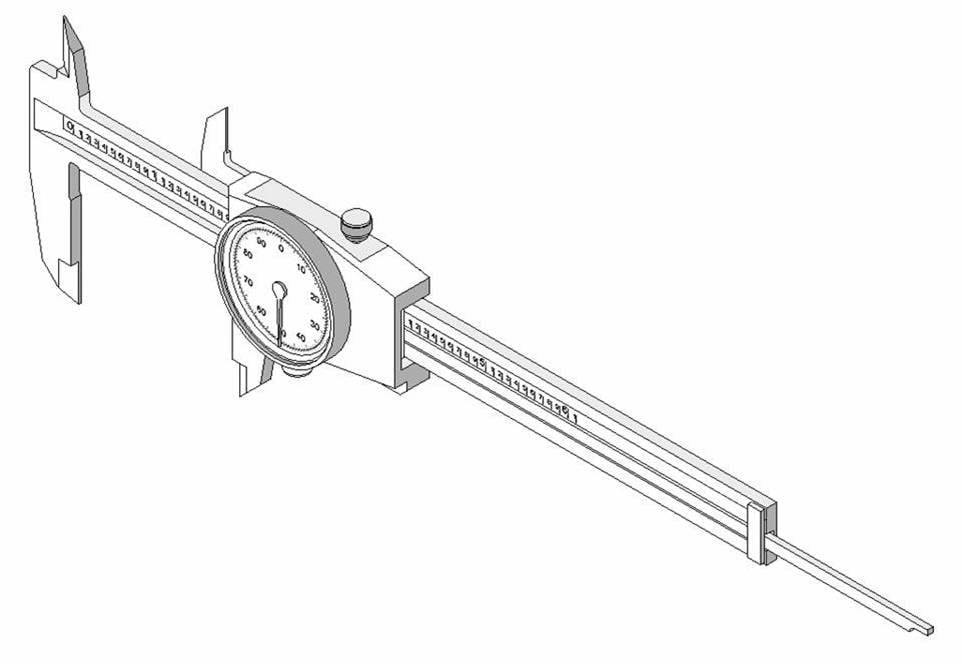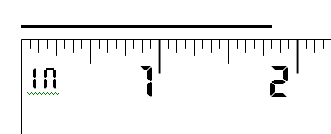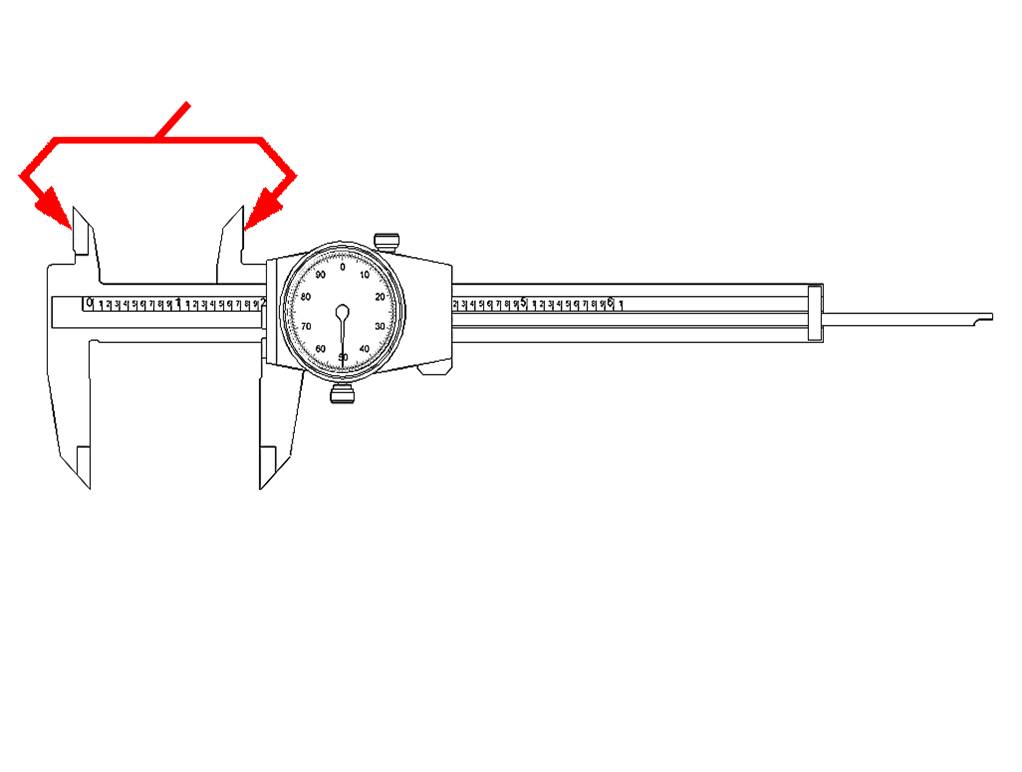IED Quiz October 9th - English To Metric, Dial Caliper, Reading Scale
-
What is the name of this measuring instrument?
-
Dial indicator
-
Dial caliper
-
Rotating ruler
-
Engineering scale
-
Precision measurer
-

This is a quiz for Intro to engineering design class. Students should be able to convert english to metric, read an english and metric scale, and reading a dial caliper.
Quiz Preview
- 2.
How long is the line?
-
2 1/16 inches
-
23 mm
-
1 5/8 inch
-
1 13/16 inches
-
1 7/16 inch
Correct Answer
A. 1 13/16 inchesExplanation
The correct answer is 1 13/16 inches.Rate this question:
-
- 3.
The jaws indicated by the red arrow are used for what type of measurement?
-
Outside diameter
-
Step measurement
-
Angle Measurement
-
Inside Diameter
-
Whole depth
Correct Answer
A. Inside DiameterExplanation
The jaws indicated by the red arrow are used for measuring the inside diameter of an object. These jaws are designed to fit into the inner part of the object being measured, allowing for an accurate measurement of its internal diameter.Rate this question:
-
- 4.
Which of the following is not a measurement that you can perform with the dial caliper?
-
Outside diameter/thickness
-
Inside diameter
-
Depth
-
Angle
-
Step
Correct Answer
A. AngleExplanation
The dial caliper is a precision measuring tool used to measure dimensions such as outside diameter, inside diameter, thickness, depth, and step. However, it cannot measure angles. Angles are typically measured using a protractor or an angle measuring tool.Rate this question:
-
- 5.
Is this an englich scale or a metric scale?
-
English
-
Metric
Correct Answer
A. MetricExplanation
The given answer "Metric" is the correct answer because the question is asking whether the scale is English or metric. The term "metric" refers to the metric system of measurement, which is widely used internationally and includes units such as meters, kilograms, and liters. Therefore, the answer indicates that the scale being referred to uses the metric system of measurement.Rate this question:
-
- 6.
Which precision measuring tool is the most versatile?
-
English scale
-
Metric scale
-
Dial indicator
-
Dial caliper
-
Engineering scale
Correct Answer
A. Dial caliperExplanation
A dial caliper is the most versatile precision measuring tool because it can measure both inside and outside dimensions accurately. It has a dial gauge that provides precise readings, making it suitable for a wide range of applications. Additionally, a dial caliper can also measure depth and step dimensions, further enhancing its versatility.Rate this question:
-
- 7.
If I have 41 eggs how many dozens do I have?
-
3.6 dozen
-
4.2 dozen
-
3.4 dozen
-
492 dozen
-
2.5 dozen
Correct Answer
A. 3.4 dozenExplanation
If you have 41 eggs and want to know how many dozens you have, you can divide 41 by 12 (since there are 12 eggs in a dozen). The result is 3.4166, which can be rounded to 3.4. Therefore, you have 3.4 dozen eggs.Rate this question:
-
- 8.
Convert 76mm to inches:
-
7.6 inches
-
1930.4 inches
-
2.992 inches
-
.2992 inches
Correct Answer
A. 2.992 inchesExplanation
To convert millimeters to inches, divide the value by 25.4 since there are 25.4 millimeters in an inch. Therefore, to convert 76mm to inches, divide 76 by 25.4 which equals 2.992 inches.Rate this question:
-
- 9.
How long is the line in mm?
-
3.4 mm
-
34 mm
-
23 mm
-
3.4 inches
-
.34 mm
Correct Answer
A. 34 mmExplanation
The correct answer is 34 mm because it is the only option that is a measurement in millimeters. The other options include inches and a decimal point, which are not compatible with the given question.Rate this question:
-
- 10.
Conver 53 mm to inches?
-
1.24 inches
-
2.09 inches
-
5.3 inches
-
1346.2 inches
-
.479 inches
Correct Answer
A. 2.09 inchesExplanation
To convert millimeters to inches, divide the measurement by 25.4. In this case, when we divide 53 mm by 25.4, we get approximately 2.09 inches.Rate this question:
-
- 11.
Convert 3.216 inches to millimeters:
-
81.7 mm
-
.127 mm
-
32.16 mm
-
88 mm
-
7.9 mm
Correct Answer
A. 81.7 mmExplanation
To convert inches to millimeters, you multiply the number of inches by 25.4. In this case, when you multiply 3.216 inches by 25.4, you get 81.7 mm.Rate this question:
-
- 12.
Why is it important for engineers/designers to be able to convert between the metric system and the english system? Anwer in complete sentences
Quiz Review Timeline (Updated): Mar 22, 2023 +
Our quizzes are rigorously reviewed, monitored and continuously updated by our expert board to maintain accuracy, relevance, and timeliness.
-
Current Version
-
Mar 22, 2023Quiz Edited by
ProProfs Editorial Team -
Oct 08, 2009Quiz Created by
Jason Dooley
How Many Inches? Quiz: Boost Your Math Skills
The How Many Inches? Quiz is a focused educational tool designed to enhance your understanding of measurements in inches. This quiz presents a series of questions that require you...
Questions:
10 |
Attempts:
44 |
Last updated:
Mar 06, 2025
|
Conversion Quiz Questions: Trivia!
The 'Conversion Quiz Questions: Trivia!' assesses knowledge in converting measurements, focusing on practical scenarios like home improvement. It tests skills in rounding,...
Questions:
10 |
Attempts:
126 |
Last updated:
Apr 15, 2025
|
Petals Of Knowledge: Celebrating National Floral Design Day
Ever wondered how much you know about floral design? Take the National Floral Design Day Quiz to put your knowledge to the test! From picking the perfect blooms to arranging...
Questions:
10 |
Attempts:
15 |
Last updated:
Feb 24, 2024
|
Video Game Design Foundations Quiz
We welcome you to this informative Video game design foundations quiz. Video games have become an integral part of society. The gamer culture is not just a hip thing but a...
Questions:
10 |
Attempts:
161 |
Last updated:
Sep 01, 2024
|
Which Core Aesthetic Are You? Quiz
Do you like aesthetic things? Ever wondered which core aesthetic you are? Find out today through this amazing quiz and be free from the nagging feeling of not knowing. The...
Questions:
10 |
Attempts:
16367 |
Last updated:
Mar 27, 2024
|
Principles Of Fashion Design Quiz
How much do you know about the principles of fashion design? What are the sets of rules that keep this industry thriving? This quiz has ten questions that will test your knowledge...
Questions:
9 |
Attempts:
764 |
Last updated:
Nov 30, 2023
|
 Back to top
Back to top












